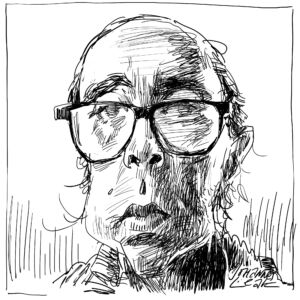Cooped-up children? Don’t blame it on the box
BBC Four’s Hop, Skip and Jump suggested that risk-aversion is a bigger problem for kids than TV and gangs.

Most adults of my generation who grew up in Britain in the 1980s will remember a television programme called Why Don’t You?. Presented by kids, for kids, it featured ways in which to entertain yourself the old-fashioned way, by creating toys, puzzles, games and magic tricks out of everyday household items or domestic refuge. Its tacit aim, as suggested by its full (and ironic) title Why Don’t You Just Switch Off Your Television Set And Go And Do Something Less Boring Instead?, was to direct children away from the passive and pacifying goggle box, and towards playing or going outside, just like their parents did in the good old days.
The BBC programme’s genesis in 1973 reflected the then growing concern that television was having a deleterious effect on children’s mental and physical development. Alas, Why Don’t You? did nothing to stem a social shift, which over the past 50 years has seen the domain for children’s recreation retreat from the streets and into the home. Today, there remains heightened concern about the amount of time children spend in front of the television; in October a government report in Australia even recommended banning under-twos from watching TV (1).
Likewise, nostalgia for simple, childlike outdoor pursuits remains as resilient as ever, especially at this time of year, as parents and grandparents grumble about having to buy their little ones a PlayStation 3 or Nintendo Wii for Christmas, when in their day ‘we made our own entertainment’ – invariably with a skipping rope, a stick, or a piece of ersatz chalk fashioned from dried, white, calcium-rich dog poo.
The nostalgists do have a legitimate point, insofar as excessive television exposure to young children has been shown to stifle language skills and reduce attention spans. In association, the failure to expose older children to the real world, in which there exists cars, unfamiliar adults, high walls and low ditches renders them unprepared to deal with adult life and all the problems, risks and dangers that are inherent to the grown-up world. However, if we are to believe BBC Four’s two-part series, Hop, Skip and Jump: The Story of Children’s Play, the story is a little more nuanced than that (2).
The second instalment of Hop, Skip and Jump shown this Tuesday, called ‘Moving Indoors’, initially gave the impression that it might follow a familiar narrative of ‘outdoors good, indoors bad’. There were the initial customary villains deemed responsible for displacing kids from the streets: mass motor car ownership, media-fuelled ‘stranger danger’, computer games, and of course television – now beloved of children because it keeps them easily entertained, and loved by many parents because it keeps their children quiet.
Yet the series also incorporated tales suggesting that we should take a more critical perspective. For instance, 55-year-old Lorraine Cavanagh, who grew up in London’s East End, recalls that she and her pals viewed the growth of motorcar ownership not as a threat, but as a challenge. ‘We’d play chicken in the road to see who could get the closest to an oncoming car while endeavouring to reach the other side of the road.’ Naturally, no one would condone such behaviour, but it does strengthen the school of thought that children are more robust than many would like to fear, and that kids are inveterate risk-takers.
Elsewhere, Colin MacFarlane, who grew up in Glasgow, remembers being inspired by a film they saw about African safaris. Alas, there were no elephants in Glasgow, but plenty of rats, so he and his pals became amateur rat-catchers instead. ‘We got quite good at it’, he recalled. Inventive as this pursuit was, you don’t have to be a health’n’safety fusspot to argue that it is not wise to let children spend a lot of time with vermin.
If you depended for all your information on tabloid newspapers and late-night Sky 3 programmes, you could be forgiven for thinking that territorial teenage gangs are a recent phenomenon, but Hop, Skip and Jump demonstrated otherwise. Another Glaswegian, Tommy Smith, remembers the city’s clearly delineated gangland borders in the late 1950s and early 1960s, talking of the relief at returning home after venturing into a fierce rival gang’s territory. Colin MacFarlane saw a man get his throat cut, after which the killer approached him and threatened: ‘If you tell anyone about this, there’ll be trouble.’ A few days later, the mark drawn around the body by the police had been covered by that icon of childhood innocence: a chalked hopscotch court.
These accounts suggest we should regard childhoods of yesterday with ambivalence – and sometimes even appreciate the often paradoxical nature of society’s nostalgia. A frequent lament by those who grew up in the 1940s and 1950s is that back then there were so many wonderful bombsites and ruined houses to explore, which is tantamount to thanking the Luftwaffe – who possibly killed these children’s parents – for a happy childhood.
Another puzzling phenomenon is that today’s nostalgia was foreseen at an early age, as many folklorists in the 1960s began tape-recording traditional playground songs, fearing they would be killed off by 45s and cheap transistor radios disseminating commercial pop music, much as recorded pop music was indeed helping to kill off much English regional folk music. Yet, as Hop, Skip and Jump illustrated, these traditional songs have survived into the twenty-first century. Many songs sung in playgrounds today would be recognised by our children’s great-grandparents. And, to add yet another twist to this tale of misleading nostalgia, because these songs have been transmitted laterally to second- and third-generation immigrants, such songs would be utterly unfamiliar to the grandparents of these children.
Television did not emerge as the unqualified malefactor here, either. As the programme reminded us, it was televised footage of the space race that aroused an interest in toy spaceships, not to mention astronomy itself. It is important to keep in mind that television and ‘real life’ are not polar opposites, two sides of a mutually antagonistic dichotomy, each jostling for children’s time and attention. In my experience, the two enjoyed a complex and often symbiotic relationship. As a boy, my pals and I used to enjoy athletic bouts of (not very accomplished) breakdancing, because we had viewed real breakdancers on Top of the Pops or John Craven’s Newsround. We would go out on the streets in the evening and pretend to be the A-Team, invariably after having just watched The A-Team. When I played football in the park I used to imagine I was the Chelsea striker Kerry Dixon, mostly because I watched Saint and Greavsie on Saturday and The Big Match on Sunday.
Hop, Skip and Jump did seem to lack a real theme, and as it had a rather hurried feel it left a rather confusing aesthetic impression. But documentaries needn’t always have a strong narrative; indeed, a good story often necessitates obscuring the complexities of history. Hop, Skip and Jump merely suggested that times have changed, and that when it comes to how we let our children play, some things are wrong today, but other things were wrong yesterday.
Patrick West is spiked’s TV and radio reviewer. Read his blog here.
Read on:
spiked-issue TV and radio
(1) ‘Ban under-2s from watching TV’, says Get Up and Grow report, The Times, 13 October 2009
(2) See Hop, Skip and Jump on the BBC iPlayer.
To enquire about republishing spiked’s content, a right to reply or to request a correction, please contact the managing editor, Viv Regan.









Comments
Want to join the conversation?
Only spiked supporters and patrons, who donate regularly to us, can comment on our articles.